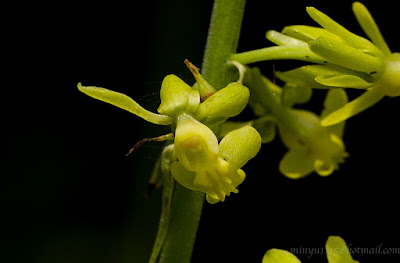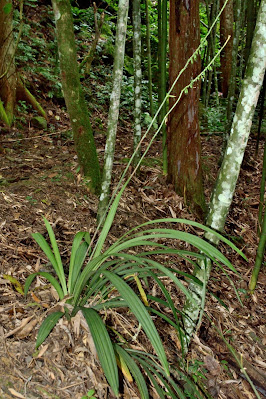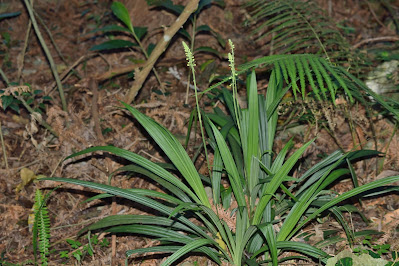Calanthe davidii - David's Calanthe blooms in the late spring and early summer with yellowish green or white, sometimes tinged purple flowers...
Calanthe davidii also called as David's Calanthe, Calanthe bungoana, Calanthe davidii var. bungoana, Calanthe ensifolia, Calanthe furcata f. matsudae, Calanthe matsudae, Calanthe pachystalix, is a species of the genus Calanthe. This species was described by Adrien René Franchet in 1888.
DESCRIPTION OF CALANTHE DAVIDII - DAVID'S CALANTHE
Calanthe davidii is native to Himalaya to Southern Japan. This orchid is found growing in forests, shaded places along valley in China North-Central, China South-Central, China Southeast, East Himalaya, Japan, Nepal, Taiwan, Tibet, Vietnam, West Himalaya at elevations of 500-3300 meters above sea level.
It is a large sized, warm to cold growing terrestrial which reaching 32-70 cm in height with indistinct rhizome and often enclosed in leaf sheaths pseudobulbs. The leaves are 3 or 4, well developed and spreading at anthesis, not deciduous, ensiform or lorate, 18-65 cm long by 0.8-2 cm wide, glabrous, with 3 main veins, apex acute with petiole-like base inconspicuous or sometimes forming a pseudostem 4–10 cm.
David's Calanthe blooms in the late spring and early summer from the 8-20 cm long, subdensely many flowered rachis on the erect, 30-120 cm long, stout, densely puberulent inflorescence that arise from the leaf axil with persistent, reflexed, narrowly lanceolate, abaxially puberulent floral bracts. The flowers are 2 cm in diameter, yellowish green or white, sometimes tinged purple.
CALANTHE DAVIDII - DAVID'S CALANTHE CARE
Cultural information should only be used as a guide, and should be to be adapted to suit you. Your physical location; where you grow your plants, how much time you have to devote to their care, and many other factors, will need to be taken into account. Only then can you decide on the cultural methods that best suit you and your plants.
Light:
Calanthe davidii needs a light level of 15000-20000 lux. The light should be bright but filtered or dispersed, and the plants should never be exposed to the direct sunlight of the midday sun. Strong air movement should be ensured all the time.
Temperature:
David's Calanthe grow well under intermediate conditions with the average temperature of the day of 24-27 ° C, the night 18-21 ° C, and the daily difference is 3-6 ° C. The rest period for this orchid is winter period triggered by cold weather and short daylight. If the orchids are kept in warm environment, they are evergreen orchids so watering should be not be retained.
Humidity:
Calanthe davidii needs the humidity of 60-80%. The plant need even moisture and humidity year round. Insufficient humidity cause stunting of plant, accelerate premature falling of buds, dehydrated and shriveled leaves, papery texture of flower edges. You can use a shallow tray of pebbles filled with water to increase humidity around your plants. Be sure the pot does not sit in water as this will rot the roots. Misting can also help in increasing humidity for limited period, but it causes leaf spot diseases if there is not good air circulation.
Substrate, growing media and repotting:
David's Calanthe require a fertile, perfectly permeable substrate. You can use a mixture of 1 part of fertile clay soil, 1 part of well-fermented manure, 1/2 part of cut osmunda fern and 1/2 part of chopped tree fern fiber or a mixture consisting of 6 parts of fine bark, 1 part of pearlite or pumice, and 3 parts of peat mixed with live moss sphagnum. One part of charcoal can be added to each of the aforementioned mixtures, which improves the airiness of the substrate and prevents it from getting sour.
The plants do not need repotting every year, once every thee years will suffice. When potting, the pseudobulbs must be half buried into the potting media.
Watering:
Calanthe davidii should be abundantly watered during active growth, but excellent drainage and aeration of the substrate must be ensured, which can never be soggy or damp.
Fertilizer:
It is recommended to use 1/2-3/4 of the recommended dose of fertilizer for orchids in the growing season every week. These orchids require high doses of fertilizers. You can use sustainable fertilizer throughout the year, but also can use high-nitrogen fertilizer from spring to mid-summer, and then until the end of autumn, high-phosphoric fertilizer.
Rest period:
David's Calanthe doesn't need a rest period. The growing conditions should be maintained throughout the year. Watering can be reduced slightly in winter, especially if the plant is grown in latitudes where there is less light and shorter days. However, these plants should never be dried out. When limiting watering in winter, fertilization should also be reduced, returning to increased watering and fertilizing in spring.















COMMENTS